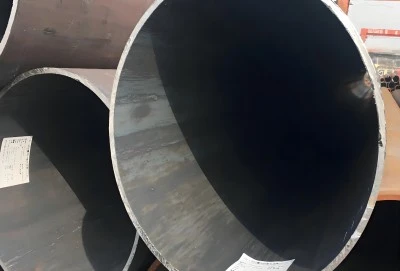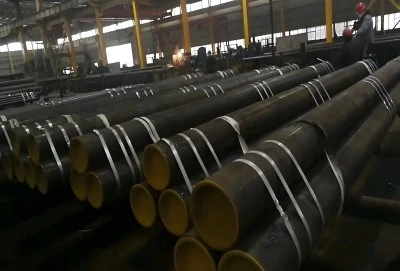S355 steel pipe is a highly favored material across numerous industries due to its outstanding mechanical properties and excellent weldability. As a low alloy steel, S355 combines high strength with significant toughness, making it ideal for demanding structural applications and projects that require durable materials. This article delves into the weldability of S355 pipes, highlighting the benefits of welding this material, factors influencing welding performance, and the various welding techniques employed. By understanding these aspects, professionals can ensure strong, reliable welds and optimize the performance of their S355 steel pipe in diverse applications.
|
|
|
Welding Advantages of S355 pipe
S355 steel pipe, as a low alloy steel, possesses several advantages when it comes to welding. Its chemical composition and mechanical properties contribute to its good weldability, making it a preferred choice for many construction and engineering projects.
One of the primary welding advantages of S355 pipe is the high strength of the welded joints. The base material's strength is maintained in the heat-affected zone (HAZ) and the weld metal, ensuring structural integrity throughout the welded component. This high strength is crucial for applications where the welded structure must withstand significant loads and stresses.
Another notable advantage is the good plasticity of S355 welded joints. Plasticity refers to the material's ability to deform without fracturing, which is essential for absorbing energy and preventing sudden failures. The welded joints of S355 pipe maintain good plasticity, allowing for some degree of deformation under load without compromising the overall structural integrity.
S355 steel also exhibits good toughness, which is the ability to absorb energy and deform plastically without fracturing. This property is particularly important in welded structures, as it helps prevent brittle fractures and enhances the overall safety and reliability of the welded component.
Furthermore, these pipe has relatively low carbon content and controlled levels of alloying elements, which contribute to its good weldability. These characteristics help minimize the risk of weld defects such as cracking and reduce the need for preheating in many welding situations.
Factors Affecting Welding Performance
While S355 pipe generally has good weldability, several factors can influence the welding performance and the quality of the resulting weld. Understanding these factors is crucial for achieving high-quality, reliable welds in S355 pipe applications.
Steel plate thickness is one of the primary factors affecting welding performance. Thicker plates typically require more heat input and may necessitate preheating to avoid rapid cooling and potential hardening in the heat-affected zone. Conversely, thinner plates may require careful control of heat input to prevent distortion and burn-through.
The welding position also plays a significant role in welding performance. Vertical and overhead welding positions are generally more challenging than flat or horizontal positions, often requiring specialized techniques and potentially affecting the choice of welding process or filler material.
The selected welding method greatly influences its welding performance. Common welding processes for S355 include shielded metal arc welding (SMAW), gas metal arc welding (GMAW), flux-cored arc welding (FCAW), and submerged arc welding (SAW). Each method has its advantages and limitations, and the choice depends on factors such as the application, joint design, and welding position.
Environmental conditions, such as temperature and humidity, can also affect welding performance. Cold temperatures may necessitate preheating to avoid rapid cooling and potential cracking, while high humidity can lead to increased hydrogen content in the weld, potentially causing hydrogen-induced cracking.
The selection of appropriate filler materials is crucial for achieving optimal welding performance. The filler metal should be compatible with the S355 base material and possess similar or slightly higher strength properties to ensure the integrity of the welded joint.
Proper joint preparation, including cleaning and beveling of the edges to be welded, is essential for achieving good fusion and minimizing the risk of weld defects. Inadequate joint preparation can lead to lack of fusion, porosity, and other weld imperfections.
Welding Process Of S355 Steel Pipe
The welding process for S355 steel pipe typically involves several steps to ensure high-quality, reliable welds. While the specific process may vary depending on the application and welding method chosen, the following general guidelines apply to most S355 pipe welding scenarios.
First, thorough joint preparation is essential. This includes cleaning the surfaces to be welded, removing any rust, scale, or contaminants that could affect weld quality. The edges of the pipe sections to be joined are typically beveled to create an appropriate joint geometry for good penetration and fusion.
Depending on the pipe thickness and ambient temperature, preheating may be necessary. Preheating helps reduce the cooling rate in the weld area, minimizing the risk of hydrogen cracking and improving the mechanical properties of the welded joint. For S355 pipe, preheating is often recommended for thicknesses above 25mm or in cold weather conditions.
The choice of welding process depends on various factors, including the pipe diameter, wall thickness, and welding position. For S355 pipe, common welding methods include:
- Shielded Metal Arc Welding (SMAW): Often used for field welding and repair work due to its versatility and portability.
- Gas Metal Arc Welding (GMAW): Suitable for shop welding and automated processes, offering high deposition rates and good weld quality.
- Flux-Cored Arc Welding (FCAW): Provides high deposition rates and is particularly useful for outdoor welding due to its wind resistance.
- Submerged Arc Welding (SAW): Ideal for large-diameter pipes and long seam welds, offering high deposition rates and excellent weld quality.
During the welding process, careful control of heat input is crucial to maintain the mechanical properties of the S355 material. Excessive heat input can lead to grain growth in the heat-affected zone, potentially reducing the strength and toughness of the welded joint.
Post-weld heat treatment (PWHT) may be required for certain applications, particularly for thicker sections or where stress relief is necessary. However, for many S355 pipe welding applications, PWHT is not mandatory if proper welding procedures are followed.
Finally, thorough inspection and testing of the completed welds are essential to ensure the integrity and quality of the welded joints. This may include visual inspection, non-destructive testing methods such as ultrasonic testing or radiography, and mechanical testing of weld specimens.
S355 Pipe For Sale
LONGMA GROUP offers a range of pipes for various applications. Their product line includes grades S355JRH, S355J0H, and S355J2H, catering to different project requirements and specifications. These grades offer slight variations in mechanical properties and chemical composition, allowing customers to select the most suitable option for their specific needs.
S355JRH is the basic grade, offering good weldability and mechanical properties suitable for many structural applications. S355J0H provides improved low-temperature toughness, making it suitable for applications where the material may be exposed to moderately low temperatures. S355J2H offers even better low-temperature toughness, making it ideal for use in more demanding environments or critical applications.
Contact Longma
LONGMA GROUP’s knowledgeable team is prepared to offer extensive information about their S355 pipes, including comprehensive details on product offerings, technical specifications, and how these pipes can effectively meet the demands of your specific project. They can provide insights into the benefits of using S355 steel, its applications, and how it aligns with your project needs. If you are currently searching for reliable S355 pipe manufacturers to ensure you receive high-quality products, LONGMA GROUP invites you to reach out to them at info@longma-group.com.














